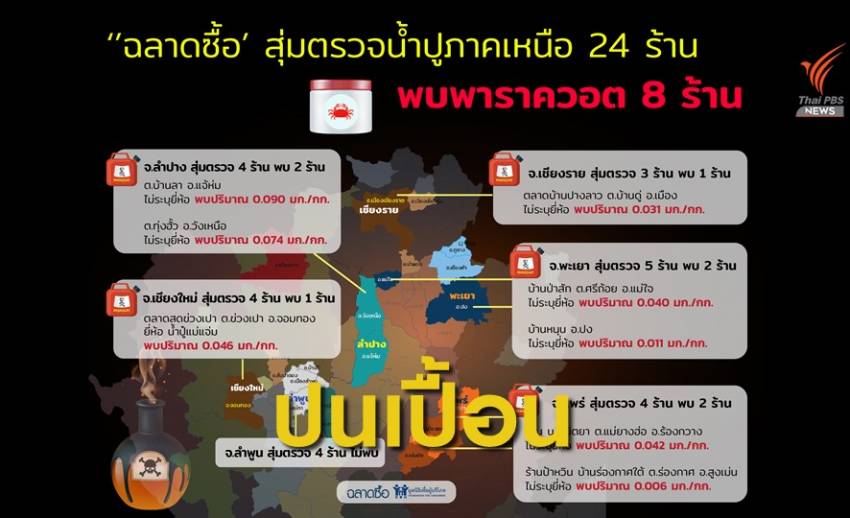
[ad_1]
The Consumer Foundation detected 33% of the “paraquat” in crab juice from 24 samples in 6 northern provinces. Ready to call the Hazardous Substances Committee to confirm the ban on all 3 hazardous chemicals
Today (September 25, 2020) Consumer Foundation Smart Shopping Test Center Release of analysis results showed residuals from 8 out of 24 parquat samples, accounting for 33% or one third of the total samples sampled in 6 provinces, and all samples have a mean value of paracord. The amount Wal is 0.04275 mg / kg.
Examples of crab water with the highest parquat residue were
1. Crab sauce, unbranded Samples were collected from Ban La sub-district, Chae Hom district, Lampang province, with a parquat content of 0.090 mg / kg.
2. Crab sauce, brand unspecified Samples were collected from Thung Hua Sub-district, Wang Nuea District, Lampang Province, with a parquat content of 0.074 mg / kg.
3. Mae Chaem Crab Juice Collecting samples from Khuang Pao Fresh Market, Khuang Pao Sub-district, Jomthong District, Chiang Mai Province, found a particle content of 0.046 mg / kg.
4. Crab sauce, unspecified Samples were collected from Miss Nittaya’s store, Mae Yang Ho Sub-district, Rong Kwang District, Phrae Province, and the parquat content was found to be 0.042 mg / kg.
5. Crab sauce, unbranded Samples were collected from Baan Pasak, Si Tho sub-district, Mae Chai district, Phayao province, with a parquat content of 0.040 mg / kg.
6. Crab sauce, unbranded Collecting samples from Ban Pang Lao Market, Ban Du Sub-District, Mueang District, Chiang Rai Province, found a parquat content of 0.031 mg / kg.
7. Crab sauce, unbranded Samples were collected from Baan Nun, Pong District, Phayao Province, and a parquat content of 0.011 mg / kg was found.
8. Crab sauce, unbranded Samples were collected from Pa Wyn, Ban Rong Kat Tai, Rongkas Sub-district, Sung Men District, Phrae Province.

According to the Foundation for Consumers and the Network of Consumer Organizations, three dangerous chemicals have been abolished, two of which are currently canceled by the Committee on Hazardous Substances, parquat and chlorpyrifos. And limit the use of glyphosate
Consumer organizations It has carried out joint campaigns and coordinated with consumer organizations from all regions to continue eliminating the 3 dangerous chemicals and monitoring food safety. Test center fit to buy AND a project to support the surveillance system of goods and services to protect the health of consumers Therefore, surveillance of contamination by agrochemicals in food in collaboration with the network of consumer organizations in the North . 24 samples of crab juice products were sampled from markets in 6 provinces across the north, including Phayao, Chiang Rai, Chiang Mai, Lampang, Lamphun, Phrae between September 7 and 15, 2020 and delivered to a standard laboratory. Analyze Parquat Residues

Ms. Saree Ong Somwang, General Secretary of the Consumer Foundation, said that from the analysis we found parquat, although it was a small amount. But it is considered illegal. Assumed that a rice that was collected from that field is a crab that has been contaminated with chemicals such as paraquat. From the above information, it can be seen that Despite the ban on import, production and sale of parquat from June 1, 2020, it has been completed. Residues of paraquat were also found in the environment and in food. It is inconsistent with the fact that the Ministry of Agriculture and Cooperatives has taken information from “Smart Buy” claiming that the parquat was not found in the Puna. As news published on August 28, the past Y is used as the reason to consider canceling the use of Parquat at the next meeting on September 28, despite the Smart Magazine random review being purchased in December 2018. This it was a random inspection of the salted rice crop used in papaya salad in and around Bangkok area. And try the smart shopping downtown I have never tasted the crab juice or crab juice from the North Thais as claimed.
The Consumer Foundation confirms that crab juice from 5 provinces out of 6 provinces has 1 out of 3 out of 24 parquat residues of all those tested.
Paraquats are known to be an acute toxic chemical. There is a serious danger Found in food waste is a health risk for all consumers. What is the cost of public health care? Chemical traders never have to bear and do not have to pay import taxes from the country. In addition to using pressure Professional recruitment lobbying negotiations for the Ministry of Agriculture and the Committee on Hazardous Substances to continually review the abolition of these hazardous chemicals.
Consumer organizations across the country are opposing a review of the cessation of the use of toxins, paraquat and chlorpyrifos. He called for maintaining a resolution on abolishing both chemicals and speeding up the phase-out of glyphosate. Carcinogenic For the safety of consumers
Ms. Puang Thong Wai Wai, the Northern Network of Consumer Organizations, said that Pu Nam Pu or Pu Nam is the local and traditional food of the North. With the same seasoning as shrimp paste It can be used to cook many things, such as chili paste, Pu Kaeng, bamboo shoots, santol, etc. To make crab water, the villagers will wash the crab well. Put turmeric and lemongrass leaves, mash until fine. The crushed crab is dissolved in water. Filter for crab water only.Then simmer for about 8 hours to get thick black thick crab juice. When making the crab juice, use up to 10 kilograms of crab to get just 1 kilogram of crab juice.
Consumers can find out about the origin of the puna. Because crabs come from cultivated farms That can control the level of cleanliness That can be safer than natural paddy fields in rice fields That they can run the risk of finding parquat, leeches, parasites or residues of other chemicals
[ad_2]